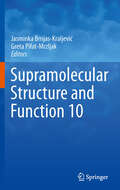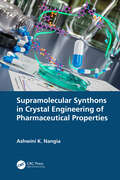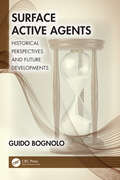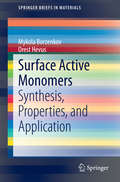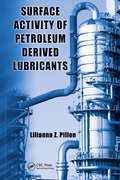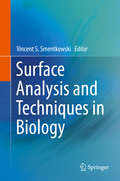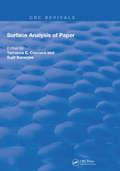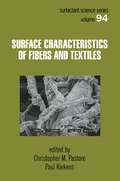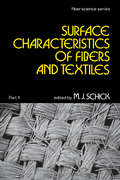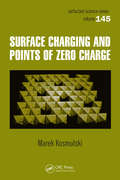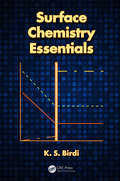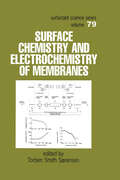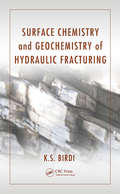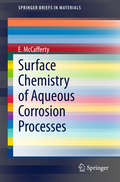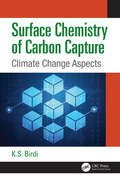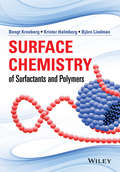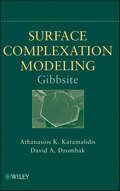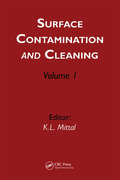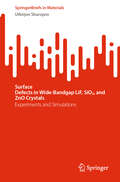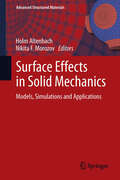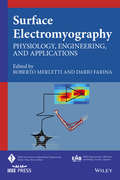- Table View
- List View
Supramolecular Structure and Function 10
by Jasminka Brnjas-Kraljević Greta Pifat-MrzljakThe book is based on lectures presented on the International Summer School on Biophysics held in Croatia in September 2009. The advantage of the School is that it provides advanced training in very broad scope of areas related to biophysics contrary to other similar schools or workshops that are centered mainly on one topic or technique. In this volume, tenth in the row, the papers in the field of biophysics are presented. The topics are biological phenomena from single protein to macromolecular aggregations structure by using variant physical methods (NMR, EPR, FTIR, Mass Spectrometry, etc.). The interrelationship of supramolecular structures and their functions is enlightened by applications of principals of these physical methods in the biophysical and molecular biology context.
Supramolecular Synthons in Crystal Engineering of Pharmaceutical Properties (xx xx)
by Ashwini K. NangiaThis comprehensive resource skillfully consolidates crystal engineering, the design of organic solids, and supramolecular synthons (i.e., structural hydrogen bond units) to achieve desired pharmaceutical properties, including solubility, dissolution, bioavailability, permeability, particle size, tableting, hydration, and mechanical strength. Covering 30 years of crystal engineering developments and pharmaceutical applications, this book will be a single and complete resource for supramolecular and structural chemists, the crystal engineering community, pharmaceutical scientists, and industrial researchers.Key Features Covers the fundamentals of crystal engineering and supramolecular synthons. Details the challenges of low solubility and low permeability facing oral drug formulations. Explains how heterosynthons provide a rational approach to address and implement solutions. Provides case studies from academic and industrial labs to walk the reader through the actual steps. Explores developments in the scale up and manufacture of crystal forms in pharmaceutical industry.
Supramolecules in Drug Discovery and Drug Delivery: Methods and Protocols (Methods in Molecular Biology #2207)
by Thomas Mavromoustakos Andreas G. Tzakos Serdar DurdagiThis detailed book aims to provide readers with critical information to accomplish the synthesis of nanosystems for the purpose of supramolecular entities complexing with drugs, targeted drug delivery system characterization, as well as the study of the physical-chemical interactions that govern the stability and properties of these systems. Beginning with a collection of chapters on drug delivery platforms such as cyclodextrins, micelles, liposomes, polymeric, nanotubes, and more, the volume continues with coverage of the study of nanotechnology systems using different biophysical techniques such as DSC, ITC, solid and liquid NMR spectroscopy, and electrochemistry. Written for the highly successful Methods in Molecular Biology series, chapters include introductions to their respective topics, lists of the necessary materials and reagents, step-by-step, readily reproducible laboratory protocols, and tips on troubleshooting and avoiding known pitfalls. Authoritative and practical, Supramolecules in Drug Discovery and Drug Delivery: Methods and Protocols serves as an ideal guide for researchers working toward drug delivery mechanisms that can tailor their physical chemical properties and enhance their efficacy, while retaining their structures intact.
Surface Active Agents: Historical Perspectives and Future Developments
by Guido BognoloThe production and use of surface active agents have seen various evolutions over time, yet rarely, if ever, has this information been collated in one place. Covering all surfactant classes in a clear and concise style, from their properties and applications to an overview of the evolution of their production processes, this book is a comprehensive overview of the field. It is both a record of important documents and intellectual property as well as a springboard for possible future developments. Key features: Covers both man-made and natural surfactants Includes abundant references to production processes and developments of intellectual property Provides a complete background to the field of surface active agents today From producers and formulators of surface active agents to professors and students of raw materials, this book is appropriate for both academic courses and industry professionals.
Surface Active Monomers
by Mykola Borzenkov Orest HevusThis brief includes information on the background of and development of synthesis of various types of surface active monomers. The authors explain the importance of utilization of surface active monomers for creation of surface active polymers and the various biomedical applications of such compounds . This brief introduces techniques for the synthesis of novel types of surface active monomers, their colloidal and polymerizable properties and application for needs of medicine and biology.
Surface Activity of Petroleum Derived Lubricants
by Lilianna Z. PillonHundreds of lubricant additives are available industry-wide to improve base stock properties and protect metal surfaces; however, the wrong combination of these commodities can result in substandard performance. Surface Activity of Petroleum Derived Lubricants explains how surface activity is affected by several factors: the interfacial properties
Surface Analysis and Techniques in Biology
by Vincent S. SmentkowskiThis book summarizes the main surface analysis techniques that are being used to study biological specimens/systems. The compilation of chapters in this book highlight the benefits that surface analysis provides. The outer layer of bulk solid or liquid samples is referred to as the surface of the sample/material. At the surface, the composition, microstructure, phase, chemical bonding, electronic states, and/or texture is often different than that of the bulk material. The outer surface is where many material interactions/reactions take place. This is especially true biomaterials which may be fabricated into bio-devices and in turn implanted into tissues and organs. Surfaces of biomaterials (synthetic or modified natural materials) are of critical importance since the surface is typically the only part of the biomaterial/bio-device that comes in contact with the biological system. Analytical techniques are required to characterize the surface of biomaterials and quantify their impact in real-world biological systems. Surface analysis of biological materials started in the 1960's and the number of researchers working in this area have increased very rapidly since then, a number of advances have been made to standard surface analytical instrumentation, and a number of new instruments have been introduced.
Surface Analysis of Paper (Routledge Revivals)
by Terrance E. Conners Sujit BanerjeeFirst published in 1995, Surface Analysis of Paper examines surface analysis techniques from a paper industry perspective and places heavy emphasis on applications. Modern techniques, including ion mass spectrometry, infrared spectroscopy, and optical profilometry are reviewed in a straightforward manner. This new book provides details on widely used methods and instruments, and discusses how they can be used to attain, for example, contour maps of the microscopic constituents on paper surfaces and accurate analyses of the physical properties of paper.Organized into three sections, Surface Analysis of Paper provides thorough coverage of the physical characteristics of paper, and a clear picture of new and emerging analytical methods. Carefully chosen background material on fundamental concepts is included wherever such material assists in understanding the uses of analysis methods. Each chapter contains: An introduction A description of the technique A discussion of the type of information that can be obtained with the particular technique Practical examples to demonstrate the advantages of the technique
Surface Characteristics of Fibers and Textiles
by Paul Kiekens Christopher M. PastoreAn exploration of the surface characteristics of fibres and textiles. It emphasizes how fibre surface affects permeability, stiffness, strength, dyeing, wrinkling, and other performance characteristics to optimize production. It also illustrates methods for developing wrinkle-resistant finishes on fibre surfaces using environmentally friendly techn
Surface Characteristics of Fibers and Textiles: Part Ii: (Fiber Science Ser. #7)
by M. J. SchickThe extraordinary growth in the production and use of man-made fibers over the past fewdecades has focused attention on the surface properties of fibers and textiles. This volumecombines surface science and technology in its presentation of the substantial progressthat has been made in the technology related to the surface characteristics of natural,synthetic, and glass fibers and textiles.Adopting an interdisciplinary approach , the coverage places emphasis upon the wetting,soiling, staining, frictional, and adhesive properties of fibers and fabrics, as well asphenomena related to these properties. The book offers critical reviews which describeexperimental facts, theories, and processes. Symbols are clearly defined in each chapter.Among the subjects covered are the surface properties of glass fibers, soil release, stainand water repellance, friction of fabrics, bonding of nonwovens, and the wetting of fibers.Surface Characteristics of Fibers and Textiles, Part II is an outstanding textbook forcourses dealing with surface chemistry, the mechanical properties of textiles, textiletechnology, and polymer chemistry . It is also a valuable reference book designed to makecurrent knowledge on these subjects accessible to industrial and academic researchers.
Surface Charging and Points of Zero Charge (Surfactant Science)
by Marek KosmulskiThe Most Detailed Resource Available on Points of Zero ChargeWith their work growing in complexity, chemists involved with surface phenomena-related projects have outgrown the common resources available to them on points of zero charge (PZC) of oxides. Reporting on a limited number of materials in a limited number of scenarios, these resources ofte
Surface Chemistry Essentials
by K. S. BirdiSurface chemistry plays an important role in everyday life, as the basis for many phenomena as well as technological applications. Common examples range from soap bubbles, foam, and raindrops to cosmetics, paint, adhesives, and pharmaceuticals. Additional areas that rely on surface chemistry include modern nanotechnology, medical diagnostics, and d
Surface Chemistry and Electrochemistry of Membranes
by Torben Smith SørensenAn eclectic mix of studies on chemical and electrochemical behaviour of membrane surfaces. The book looks at membranes - both organic and inorganic - from a host of different perspectives and in the context of many diverse disciplines. It explores the behaviours of both synthetic and biological membranes, employing physical, chemical and physiochem
Surface Chemistry and Geochemistry of Hydraulic Fracturing
by K. S. BirdiUnique in focus, Surface Chemistry and Geochemistry of Hydraulic Fracturing examines the surface chemistry and phenomena in the hydrofracking process. Under great scrutiny as of late, the physico-chemical properties of hydrofracking are fully detailed and explained. Topics include the adsorption-desorption of gas on the shale reservoir surface and relevant waste-water treatment dependent on various surface chemistry principles. The aim of this book is to help engineers and research scientists recognize the basic surface chemistry principles related to this subject. Written by a long-time expert in the field, this book presents an unbiased account of the hard science and engineering involved in a resource that is gaining growing attention within the community.
Surface Chemistry and Macroscopic Assembly of Graphene for Application in Energy Storage
by Cheng-Meng ChenThis PhD thesis presents the latest findings on the tunable surface chemistry of graphene/graphene oxide by systematically investigating the tuning of oxygen and nitrogen containing functional groups using an innovative carbonization and ammonia treatment. In addition, novel macroscopic assemblies or hybrids of graphene were produced, laying the theoretical foundation for developing graphene-based energy storage devices. This work will be of interest to university researchers, R&D engineers and graduate students working with carbon materials, energy storage and nanotechnology.
Surface Chemistry of Aqueous Corrosion Processes
by E. MccaffertyThis SpringerBrief utilizes a surface chemistry/physical chemistry approach toward the study of aqueous corrosion processes. The book starts with a timely and in-depth review of Acid-Base Properties of Surface Oxide Films. Acid-base properties are significant in various surface phenomena such as general and localized corrosion, corrosion inhibition by organic molecules, and the adhesion of organic polymers to oxide-covered metals. This review also discusses the relationship between the two measures of surface charge, the isoelectric point of the oxide film and the potential of zero charge of the oxide-covered metal. Other topics included are capillarity and corrosion, corrosion inhibition, passivity of Fe-Cr and Fe-Cr-Ni alloys, the uptake of chloride Ions and the pitting of aluminum, and the formation of water films on the iron oxide surface.
Surface Chemistry of Carbon Capture: Climate Change Aspects
by K. S. BirdiSurface Chemistry of Carbon Capture: Climate Change Aspects provides comprehensive and up-to-date literature on carbon capture and storage (CCS) technology and delineates the surface chemistry of this process. Mankind is dependent on energy from gas, oil, coal, atomic energy, and various other sources. In all fossil fuel combustion processes, carbon dioxide (CO2) is produced (ca. 25 Gt/year). In the past few decades, we have observed a constant increase in CO2 content in the air (currently ca. 400 ppm [0.04%]). This book discusses the technology related to carbon (i.e., CO2) capture and sequestration (CCS) from fossil fuel energy plants, which is considered an important means of CO2 control. It also covers the adsorption/absorption processes of CO2 on solids and similar procedures to help address growing climate change concerns.
Surface Chemistry of Surfactants and Polymers
by Bengt Kronberg Krister Holmberg Bjorn LindmanThis book gives the reader an introduction to the field of surfactants in solution as well as polymers in solution. Starting with an introduction to surfactants the book then discusses their environmental and health aspects. Chapter 3 looks at fundamental forces in surface and colloid chemistry. Chapter 4 covers self-assembly and 5 phase diagrams. Chapter 6 reviews advanced self-assembly while chapter 7 looks at complex behaviour. Chapters 8 to 10 cover polymer adsorption at solid surfaces, polymers in solution and surface active polymers, respectively. Chapters 11 and 12 discuss adsorption and surface and interfacial tension, while Chapters 13- 16 deal with mixed surfactant systems. Chapter 17, 18 and 19 address microemulsions, colloidal stability and the rheology of polymer and surfactant solutions. Wetting and wetting agents, hydrophobization and hydrophobizing agents, solid dispersions, surfactant assemblies, foaming, emulsions and emulsifiers and microemulsions for soil and oil removal complete the coverage in chapters 20-25.
Surface Complexation Modeling: Gibbsite
by David A. Dzombak Athanasios K. KaramalidisThis book provides a description of the generalized two layer surface complexation model, data treatment procedures, and thermodynamic constants for sorption of metal cations and anions on gibbsite, the most common form of aluminum oxide found in nature and one of the most abundant minerals in soils, sediments, and natural waters. The book provides a synopsis of aluminum oxide forms and a clearly defined nomenclature. Compilations of available data for sorption of metal cations and anions on gibbsite are presented, and the results of surface complexation model fitting of these data are given. The consistency of the thermodynamic surface complexation constants extracted from the data is examined through development of linear free energy relationships which are also used to predict thermodynamic constants for ions for which insufficient data are available to extract constants. The book concludes with a comparison of constants extracted from data for sorption on gibbsite with those determined previously for hydrous ferric oxide (HFO), hydrous manganese oxide (HMO), and goethite.The overall objective of this book is the development and presentation of an internally consistent thermodynamic database for sorption of inorganic cations and anions on gibbsite, an abundant and reactive mineral in soils, sediments, and aquatic systems. Its surface has a high affinity for sorption of metal cations and anions, including radionuclides. The gibbsite database will enable simulation and prediction of the influence of sorption on the fate of these chemical species in natural systems and treatment processes in which aluminum oxides are abundant. It thus will help to advance the practical application of surface complexation modeling.
Surface Contamination and Cleaning: Volume 1
by K. L. MittalThis volume documents the proceedings of the International Symposium on Surface Contamination and Cleaning, held in Newark, New Jersey, May 23-25, 2001. Because of the importance of this topic in many technological areas, tremendous efforts have been devoted to devise novel and more efficient ways to monitor, analyse and characterize contamination
Surface Defects in Wide-Bandgap LiF, SiO2, and ZnO Crystals: Experiments and Simulations (SpringerBriefs in Materials)
by Utkirjon SharopovThis book deals with surface defects in wide-bandgap crystals of lithium fluoride, silicon dioxide, and zinc oxide. Encompassing topics such as radiation-induced amorphization, crystallization, and various microstructural developments arising from defect production and annealing, the book delves into controlled modifications of physical and chemical properties, micro and nano-structuring of surfaces, and the creation and behavior of structures far from thermal equilibrium, including supersaturated solid solutions, ion tracks, and surfaces treated with electron- and high-intensity ion beams. Beyond its relevance to the academic community, this monograph serves as a valuable resource for design and installation organizations, offering insights for specialists involved in the development of modern, new, and energy-efficient innovative materials. The applicability extends to traditional silicon energy and semiconductor electronics, providing practical knowledge for professionals engaged in these fields. Additionally, the work is of significance to a broad spectrum of specialists and managers in various organizations involved in the development of lithium-ion batteries for energy storage systems, especially those employing cutting-edge high-performance materials. As a comprehensive reference in materials science, this monograph caters to a diverse audience engaged in the ongoing advancements and applications within this dynamic field. It is suitable for scientific and engineering professionals, as well as researchers specializing in materials science, physics, semiconductors, photovoltaics, defects engineering, laser technology, solid-state physics, and beam-enhanced synthesis and modification of materials.
Surface Diffusion: Metals, Metal Atoms, and Clusters
by Grażyna Antczak Gert EhrlichFor the first time, this book unites the theory, experimental techniques and computational tools used to describe the diffusion of atoms, molecules and nanoparticles across metal surfaces. Starting with an outline of the formalism that describes diffusion on surfaces, the authors guide the reader through the principles of atomic movement, before moving on to diffusion under special circumstances, such as the presence of defects or foreign species. With an initial focus on the behaviour of single entities on a surface, later chapters address the movement of clusters of atoms and the interactions between adatoms. While there is a special emphasis on experimental work, attention is paid to the increasingly valuable contributions theoretical work has made in this field. This book has wide interdisciplinary appeal and is ideal for researchers in solid state physics, chemistry as well as materials science, and engineering.
Surface Effects in Solid Mechanics
by Holm Altenbach Nikita F MorozovThis book summarizes the actual state of the art and future trends of surface effects in solid mechanics. Surface effects are more and more important in the precise description of the behavior of advanced materials. One of the reasons for this is the well-known from the experiments fact that the mechanical properties are significantly influenced if the structural size is very small like, for example, nanostructures. In this book, various authors study the influence of surface effects in the elasticity, plasticity, viscoelasticity. In addition, the authors discuss all important different approaches to model such effects. These are based on various theoretical frameworks such as continuum theories or molecular modeling. The book also presents applications of the modeling approaches.
Surface Electromagnetics: With Applications in Antenna, Microwave, and Optical Engineering
by Fan Yang Yahya Rahmat-SamiiWritten by the leading experts in the field, this text provides systematic coverage of the theory, physics, functional designs, and engineering applications of advanced engineered electromagnetic surfaces. All the essential topics are included, from the fundamental theorems of surface electromagnetics, to analytical models, general sheet transmission conditions (GSTC), metasurface synthesis, and quasi-periodic analysis. A plethora of examples throughout illustrate the practical applications of surface electromagnetics, including gap waveguides, modulated metasurface antennas, transmit arrays, microwave imaging, cloaking, and orbital angular momentum (OAM ) beam generation, allowing readers to develop their own surface electromagnetics-based devices and systems. Enabling a fully comprehensive understanding of surface electromagnetics, this is an invaluable text for researchers, practising engineers and students working in electromagnetics antennas, metasurfaces and optics.
Surface Electromyography: Physiology, Engineering, and Applications
by Dario Farina Roberto MerlettiReflects on developments in noninvasive electromyography, and includes advances and applications in signal detection, processing and interpretation. Addresses EMG imaging technology together with the issue of decomposition of surface EMG. Includes advanced single and multi-channel techniques for information extraction from surface EMG signals. Presents the analysis and information extraction of surface EMG at various scales, from motor units to the concept of muscle synergies.
